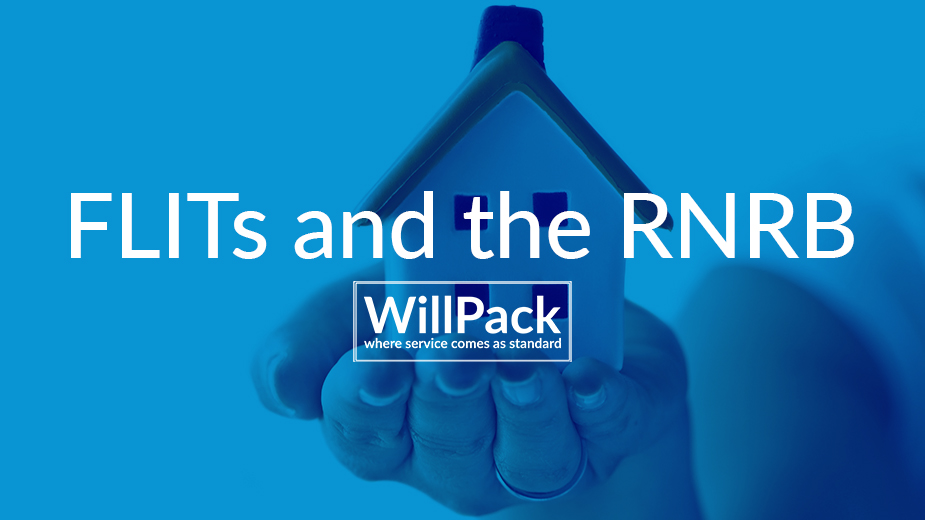Ever since the Residential Nil Rate Band (RNRB) was announced, one of our most common queries has been how it relates to Flexible Life Interest Trusts (FLITs).
What are FLITs
FLITs are essentially a life interest for a person (usually the surviving spouse), with an underlying discretionary trust that will arise when the surviving spouse dies. FLITs for IHT purposes are a mixture between an interest in possession and a relevant property trust. Whilst the life tenant of a FLIT is alive, the property is treated as an interest in possession trust however once the life tenant has died the property is treated as a relevant property trust.
Trusts and RNRB
Where property left to certain types of trust by Will are seen as inherited under S8J(4) Inheritance Tax Act 1984 by the beneficiary/beneficiaries of the Trust. These are:
- Immediate Post Death Interest Trusts (life interest trusts set up on the death of the testator).
- Disabled Person’s Trusts; and
- Bereaved Minors or Bereaved Young Persons Trusts
Discretionary Trusts are not included on this list. However, should the client’s main residence form part of a discretionary trust on the client’s death by their will, there is one method that can be used to claim RNRB.
Under S144 Inheritance Tax Act 1984, if assets are appointed out of a discretionary trust to a beneficiary within two years of death, for IHT purposes it is seen as if the will had gifted the assets to the beneficiary and not to the trust.
Where, immediately before a deceased’s death, a property is held on an interest in possession trust for the deceased, on death the remaindermen of the trust will be seen as inheriting the property out of the deceased’s taxable estate.
How does the RNRB apply to a FLIT?
If a share in a main residence forms part of the FLIT, how the RNRB would be applied is easiest illustrated by example.
T1 and T2 are married and own their home 50:50 as tenants in common. T1 dies leaving his estate to a FLIT, his wife T2 is the life tenant of the trust and their descendants are discretionary beneficiaries.
At this point, the FLIT is an interest in possession trust. The property is seen as inherited by T2 for IHT purposes. The spousal exemption will apply and no IHT will be due over the property. As the RNRB of T1 is unused on his death, the unused RNRB is available to be transferred to potentially be used on T2’s death.
On T2’s death, the trust will continue as a discretionary trust. The situation with RNRB gets confusing here.
50% of the property was held in an interest in possession trust. It is therefore seen as part of the T2’s taxable estate on her death. For IHT purposes, this share is then seen as passing from T2’s estate into a discretionary trust. RNRB is therefore not available over this share. S144 Inheritance Tax Act cannot be used here, as it only applies to distributions by the terms of the deceased’s Will. In this case, the property is passing from T2’s taxable estate into a discretionary trust not by the terms of T2’s Will, but by the terms of the trust set up by T1’s Will.
The remaining 50% of the property however is owned by T2 outright. If T2 never rewrote her will to remove the FLIT it would be set up as a discretionary trust on her death as the life tenant has predeceased her. If the property remains in the trust for over two years, RNRB would not be available. However, should this 50% be distributed out of the trust within two years of T2’s death to her children, RNRB would be available over this 50%.
Allowing the property to form part of a FLIT does potentially allow for RNRB to be claimed, but it would be down to the trustees to act efficiently and it is therefore not guaranteed. The value of half of the property may also not be enough for full RNRB to be apply.
PPTs and RNRB
If a client wishes to ensure RNRB, we advise that the main residence be placed into a separate PPT.
A PPT is an interest in possession trust and on the death of the life tenant, the trust ends. In the most common circumstance of spouses owning a house equally, the deceased on first death gives their spouse a life interest in their main home and then the property passes to their children, RNRB should be available.
If T1 and T2 had placed their home into a PPT instead of allowing it to all into the FLIT, the effect on first death is the same as the trusts are both interest in possession trusts.
On second death, the trust will end. RNRB will be available as:
T2 owns 50% of the property outright, this would pass to the children.
On T2’s death, they had an interest in possession in the other 50%. This is seen as part of their estate for IHT purposes and passes to their children.
The executors on second death can apply both T2’s RNRB and T1’s unused RNRB towards the property.
This does mean that children would inherit the main residence outright, and the ongoing protection of the discretionary trust in the FLIT is lost for the home. Here the clients do need to choose between whether IHT efficiency or ongoing protection is more important to them.
*all references to a spouse includes a civil partner.


 © Trust Wills & Probate Limited t/a WillPack. All rights reserved.
© Trust Wills & Probate Limited t/a WillPack. All rights reserved.
One comment
Pingback: Inheritance Tax Planning via a Will — WillPack
Comments are closed.